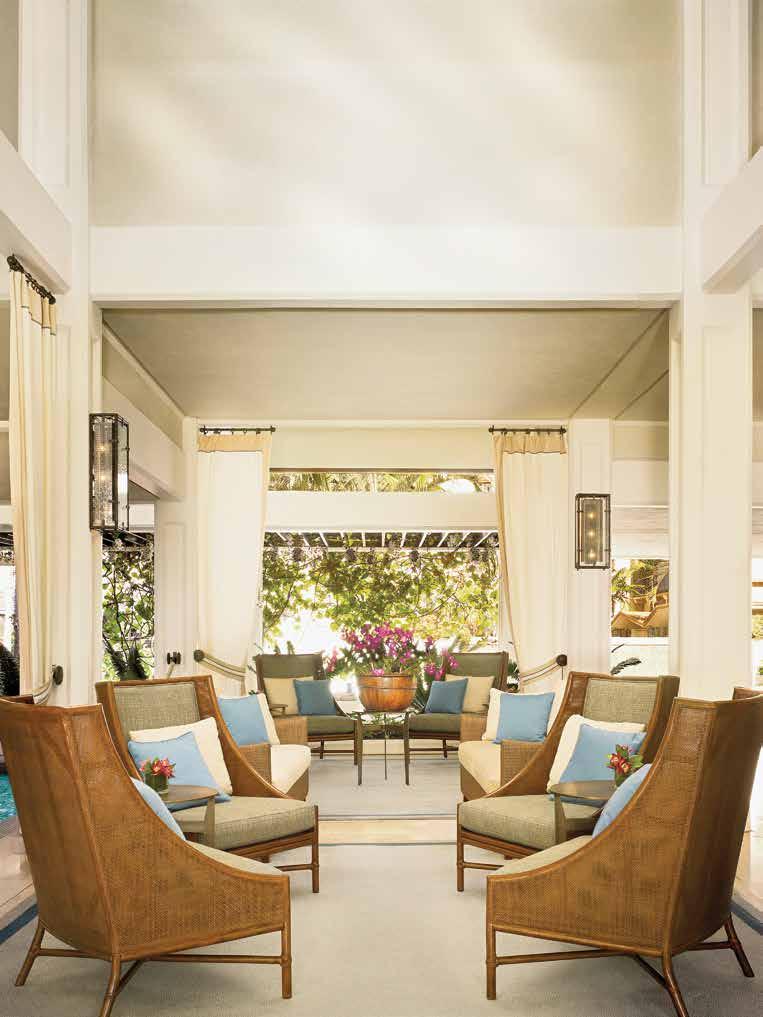
 Ulrich Krauer General Manager Halekulani
Ulrich Krauer General Manager Halekulani
As the middle of summer arrives, and with it longer days and shorter nights, we celebrate the recent opening of only the second Halekulani on July 26, 2019. Welcome Halekulani Okinawa to our ‘ohana! Hawai‘i has a strong bond with the people of Okinawa and its culture. We try to reflect that with a couple of stories in this issue.
While many are aware of O‘ahu’s reputation as a melting pot of different cultures and cuisines, it may come as a surprise to learn it is home to one of the largest Okinawan populations outside of Japan. As one of the world’s only “blue zones,” Okinawans are known to live longer lives, in no small part due to their food. Learn about the different Okinawan eateries, ranging from “hole-in-the-wall” to upscale, and how specific ingredients are significant.
In this issue of Living discover kendo, the Japanese martial art with roots of swordsmanship, that is practiced worldwide. Enjoy, perhaps, the Shangri La Museum, a favorite of many of our guests. We give you some of the first images of the newly renovated spaces and invite you to take the tour on your next visit.
As we look into unique artists, we delve into the works of renowned author James Michener, of the novel Hawaii. Learn more about the connection between Michener and modern Japanese prints, some of which are currently on display at the Honolulu Museum of Art. Read about our own award-winning jazz and Lewers Lounge performer Maggie Herron.
Last but not least, we pay tribute to a United States Poet Laureate and Pulitzer Prize for Poetry winner, W.S. Merwin. Mr. Merwin made Maui his home for the final years of his life before passing earlier this year. We visit his palm forest on Maui and showcase this prized legacy. His poems continue to inspire readers to lead more eco-conscious lives.
To see exciting digital content of some of our Living stories, past and present, please visit us at halekulaniliving.tv. We hope that you enjoy this edition of Living and that it serves as a reminder for you to return to stay with us.
Warmly,
Ulrich Krauer General Manager Halekulani一段と日が長くなり、本格的な夏の到来を迎えた2019年7月26日、世 界で2つ目のハレクラニとして「ハレクラニ沖縄」が新たにグループに加 わり、オープ二ングを祝いました。歴史的にも、沖縄の人々や文化と繋 がりの強いハワイ。今号のリビングでは、そんな沖縄とハワイの関係を テーマにしたストーリーを特集しています。
ハワイが多様な文化や料理の集まる人種のるつぼであることは周知 の通りですが、ハワイに暮らす沖縄県出身者の人口が、日本国外最大で あることには驚かれるかもしれません。世界でも類をみないほど健康で 長寿な地域とされる「ブルーゾーン」の沖縄。県民の長寿の秘訣は、そ の食生活にあると言われています。こじんまりとした店から高級店まで、 ホノルルの沖縄料理店と沖縄の郷土料理に欠かせない食材についても ご紹介しています。
また今号のリビングでは、日本の剣術が元となり、世界に広まってい った武術、剣道のハワイでの歴史について、そして第二次世界大戦後、 ホノルルに建設された日本風家屋のアール・アーンスト氏の住居を訪ね ます。ゲストの皆様からご好評をいただいているシャングリ・ラ・イスラ ム美術文化デザイン博物館のツアーについても、改修工事を終えて新 たに公開されたエリアの最新の画像を交え、ご案内しています。 アートの特集ページでは、小説『ハワイ』の著者で、有名な小説家の ジェームズ・ミッチェナー氏の作品の魅力についてご紹介しています。ホ ノルル美術館でも展示されている現代日本版画とミシェナー氏との関 係について、詳しくご紹介しています。スポットライトでは、ハレクラニの ルワーズ ラウンジで演奏し、数々の賞に輝くジャズアーティストのマギ ー・ヘロンに焦点を当てます。
最後に、晩年をマウイ島で過ごし、今年の始めにこの世を去ったピュ ーリッツァー賞受賞の米国人桂冠詩人、W.Sマーウィン氏に捧げるス トーリーでは、不毛の地に植えた椰子の苗木が50年以上かけて世界 有数の椰子の木の森に成長し、現在では保護区となっているマーウィ ン・コンサーバンシーを訪れます。読者に環境に配慮した生活を送るた めのヒントを与えくれるマーウィン氏の詩の世界にも触れてください。 リビングのストーリーは、halekulaniliving.tvのデジタルコンテンツ でもお楽しみいただけます。今号のリビングをお楽しみいただき、これら のストーリーが読者の皆様が再びハワイを訪れるきっかけとなりますこ とを願っております。
心を込めて ハレクラニ総支配人 ウーリック・クラワー




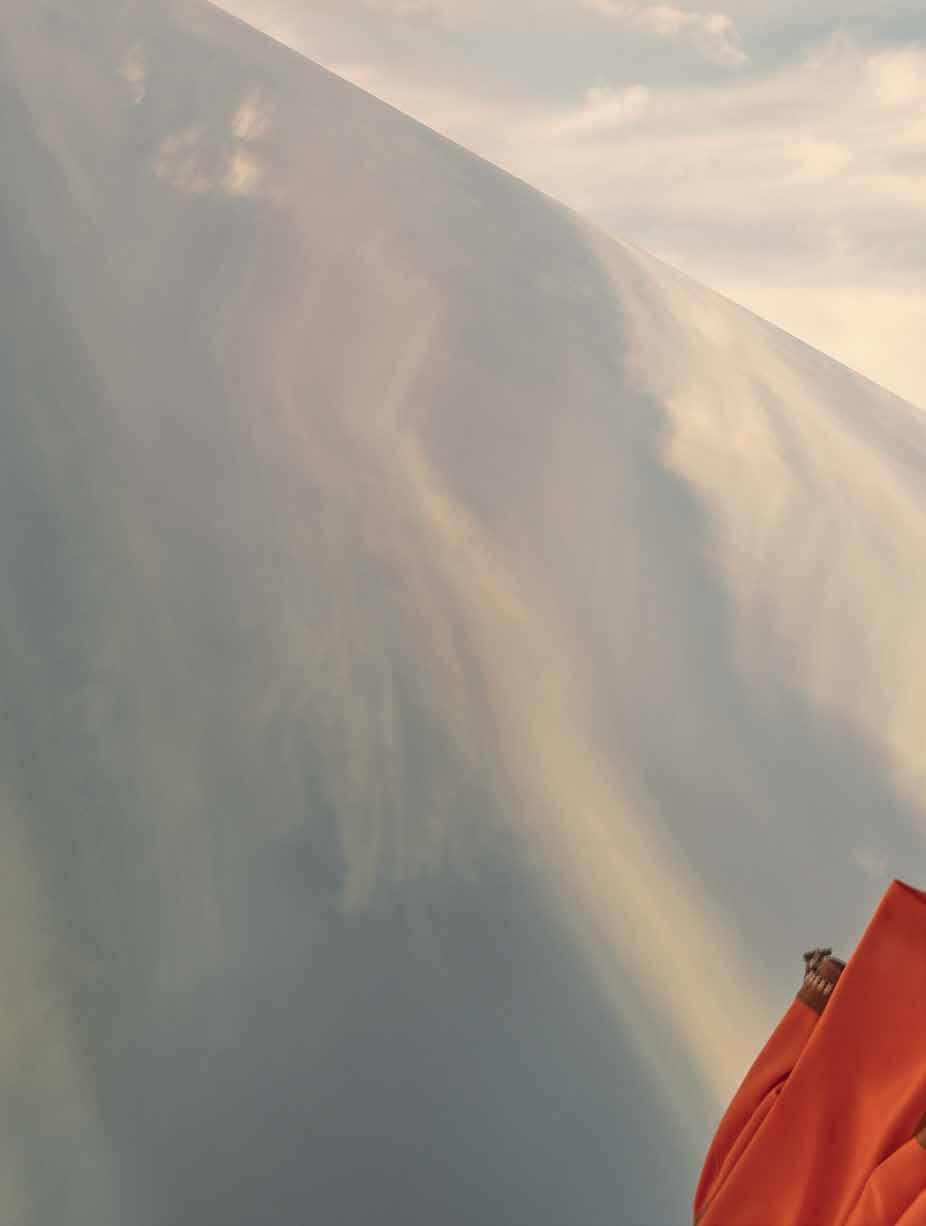




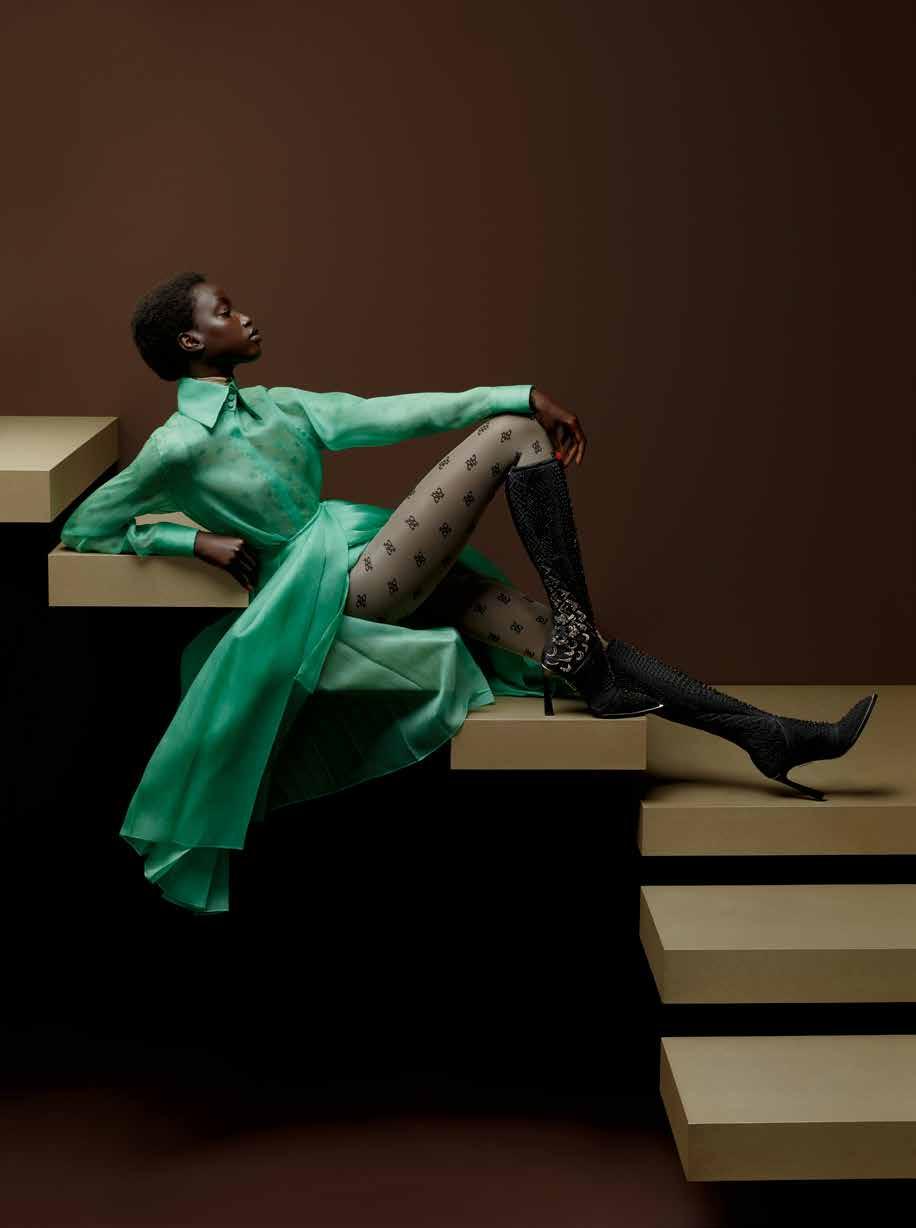







HALEKULANI CORPORATION
CHIEF OPERATING OFFICER
PETER SHAINDLIN
CHIEF EXECUTIVE ADVISOR
PATRICIA TAM
CHIEF EXECUTIVE OFFICER
JASON CUTINELLA
CHIEF REVENUE OFFICER
JOE V. BOCK
JOE@NMGNETWORK.COM
GENERAL MANAGER, HALEKULANI
ULRICH KRAUER
DIRECTOR OF SALES & MARKETING
GEOFF PEARSON
CREATIVE DIRECTOR ARA LAYLO
EDITORIAL DIRECTOR
MATTHEW DEKNEEF
HALEKULANI.COM
1-808-923-2311
2199 KALIA RD. HONOLULU, HI 96815
PUBLISHED BY NMG NETWORK
36 N. HOTEL ST., SUITE A HONOLULU, HI 96817 NMGNETWORK.COM
© 2019 by Nella Media Group, LLC. All rights reserved. No part of this publication may be reprinted without the written consent of the publisher. Opinions are solely those of the contributors and are not necessarily endorsed by NMG Network.


Islamic symmetry at Shangri La Museum of Islamic Art, Culture, & Design.


A walk through the property at the Earle Ernst residence in Mānoa.
マノアにあるアール・アーンス ト氏の邸宅の庭を散策。
Explore: Pōhuehue
Explore: W.S. Merwin
Spotlight: Harry Winston
The cover image, photographed by Mark Kushimi, of model Tiare Thomas exploring the lush gardens of a dwelling designed by the firm of Wimberly & Cook. Turn to the fashion story on page 102 and watch the video at halekulaniliving.tv.
Halekulani Living


The bold flavors of Okinawan dishes, at a glance.
味わい深い沖縄料理
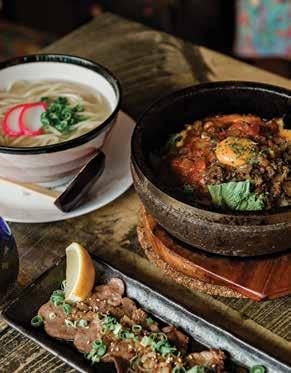

84 ABOUT THE COVER:
表紙について:
TABLE OF CONTENTS
目次
ARTS 24
創作版画の魅力 32
五感を呼び覚ます場所 44 ラウンジの淑女 50
夢の島 CUISINE 62
美味しい沖縄 CULTURE 74
音楽のパイオニア
Kendo requires speed, strength, and grace. 62
速さと強さ、品格が問われる剣道
マーク・クシミ氏撮影の表紙の写真に写っているのは、ウィンバリー&クック社によって設計された、緑豊かな庭園を 散策するモデルのティアレ・トーマスさん。ファッションのストーリーは、本誌102ページまたはhalekulaniliving.tvの ビデオをご覧ください。
84
剣の道 FASHION 102
島と調和する住まい CITY GUIDES 118 ポーフエフエの咲く道 124 マーウィンの起こした改革 134 スポットライト: ハリー・ウィンストン
Halekulani Living
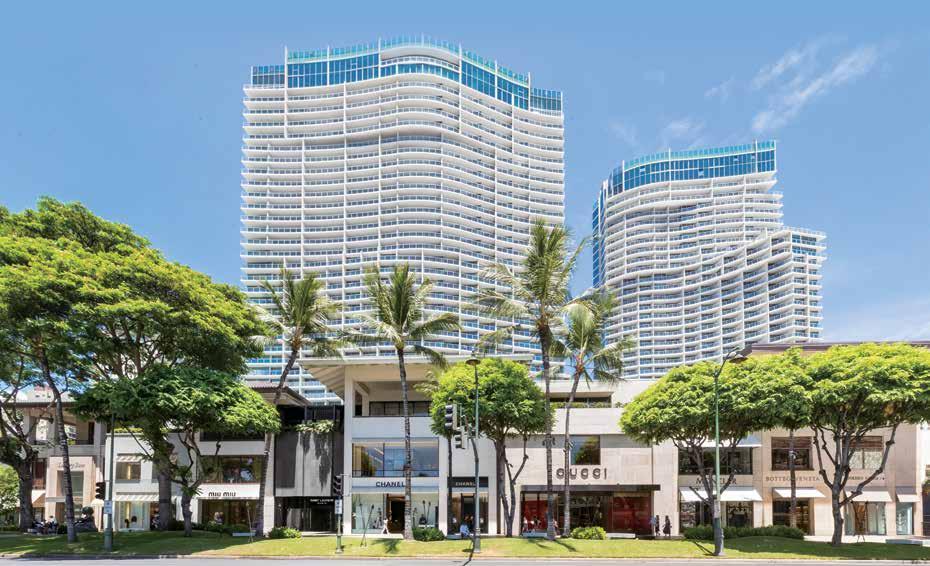

Living TV is designed to complement the understated elegance enjoyed by Halekulani guests, with programming focused on the art of living well. Featuring cinematic imagery and a luxurious look and feel, Living TV connects guests with the arts, style, and people of Hawai‘i. To watch all programs, tune into channel 2 or online at halekulaniliving.tv.
客室内でご視聴いただけるリビング TVは、ハレクラニならではの上質な寛 ぎのひとときをお過ごしいただくため、 豊かで健康的なライフスタイルをテー マにしたオリジナル番組をお届けして います。臨場感溢れる映像で芸術やフ ァッション、食文化、ハワイの人々につ いてのストーリーをお楽しみください。
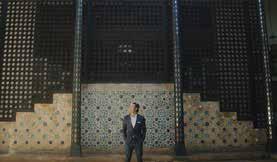


SITE FOR THE SENSES
In east Honolulu is Shangri La, a breathtaking space of architectural and cultural wonders.
五感を呼び覚ます場所 ホノルルの東部にあるイスラム文化と建築のエキゾチックな魅 力に触れることのできる幻想的な空間、シャグリ・ラ
LADY OF THE LOUNGE
Maggie Herron, the jazz-belting pianist at Lewers Lounge, sets the mood each week with bluesy standards.
ラウンジの淑女 ブルース調のスタンダードを演奏するルワーズ ラウンジの ジャズピアニストのマギー・ヘロン
A MUSICAL PIONEER
Kilin Reece, a luthier on O‘ahu, protects the integrity of Hawai‘i's beloved stringed instruments.
音楽のパイオニア ハワイで愛されている弦楽器について研究するオアフ島の弦楽 器職人のキリン・リース
watch online at: halekulaniliving.tv


LEGACY OF THE SWORD
A Honolulu kendo club keeps the Japanese art of the sword alive and helps students strengthen body, mind, and spirit.
身体と心と精神を鍛える日本の武術、剣道の伝統を守り続ける ホノルルの剣道クラブ
ISLAND HARMONY
島と調和する住まい
Experience the soothing Japanese-inspired design of one of Hawai‘i’s most influential architects.
日本の建築様式を取り入れた有名建築家によるハワイの建築 剣道













IMAGES COURTESY OF HONOLULU MUSEUM OF ART
文=スペンサー・ケアラマキア
写真=ホノルル美術館提供
ALLUREMENT INFINITE
創作版画の魅力
Drawn to a bold new world of Japanese printmaking, novelist James Michener developed a keen awareness for a generation of experimental and emerging print artists.
斬新で大胆な日本の版画に魅せられた小説家のジェームズ・ミッチェナー
opposite: Portrait of Author Hagiwara Sakutarō, Onchi Kōshirō (1891–1955). Japan, 1943. Woodblock print; ink and color on paper. Gift of James A. Michener, 1991.
反対のページ:作家の萩原朔 太郎氏の肖像画、恩地孝四郎 (1891–1955)、日本、1943年。
木版、紙、インクとカラー。
1991年ジェームズ・A・ミッチェ ナー寄贈。
When it was published in 1962 in a limited run, each of the 475 copies of novelist James Michener’s The Modern Japanese Print: An Appreciation was presented in an unvarnished spruce slipcase branded with the seal of the Sosaku-hanga, a creative prints art movement. The book’s handmade kyokushi (vellum paper) pages were bound in a three-color, fine-weave hemp cloth, the front boards and spine stamped in gilt. In its first printing, the book was as much a work of fine art as the 10 signed prints it contained.
Michener was already an international celebrity in 1962. His story collection Tales of the South Pacific had won a Pulitzer Prize and been adapted for the stage and screen as the musical South Pacific His novels were bestsellers, including Hawaii , a 1,100-page saga chronicling the islands’ history and peopling.
He was also fascinated by Japanese printmaking. In the 1950s, he began amassing a private collection of prints and was zealous enough to write three books on the subject. His first, 1954’s The Floating World , examined the growth and decline of Ukiyo-e, which translates to “pictures of the floating world,” during the Edo period (1603 to 1867). Five years later, Michener followed it with Japanese Prints: From the Early Masters to the Modern , in which he expanded his scholarship to include 20th-century approaches to the tradition. His third book, Modern Japanese Print , can be understood as a continuation of his efforts to expose American audiences to the artform, this time shining a light on the obscure, Westerninfluenced Sosaku-hanga movement.
1962年に475冊のみ出版された小説家ジェームズ・ミッチェナーさ んの『現代日本版画:感謝』は、一冊ずつ丁寧に「創作版画」の印が押 された質素な外箱に入っている。手作りの局紙を使ったページに3色 の上等な麻布の装丁が施され、表紙と背表紙に金箔の文字が刻印さ れたこの初版は、本そのものが中身の10枚のサイン入り版画と同じく らい価値のある芸術作品に仕上がっている。
1962年当時、すでに国際的に有名な小説家であったミッチェナ ーさんは、『南太平洋物語』でピューリッツァー賞を受賞し、その本をも とにした『南太平洋』というミュージカルや映画も製作された。1959 年出版の小説『ハワイ』は、島の歴史と人々の記録を何千ページにもわ たって綴ったベストセラーだ。
そんなミッチェナーさんが日本の版画に関心を持ち、版画の収 集を始めたのは1950年代。版画を題材にした本を3冊執筆するほど の熱心な収集家であった。1954年に執筆した『ザ・フローティングワ ールド』では、江戸時代(1603年~1867年)の浮世絵の成長と衰退 を分析し、その5年後には、日本の伝統芸術を20世紀の現代的なアプ ローチで研究した『日本の版画:初期の巨匠から現代まで』を発表。3 冊目の『現代日本版画』では、西洋の影響を受けた創作版画の魅力を アメリカ人に向けてわかりやすく解説している。


Woman of Brittany, Yamamoto Kanae (1882–1946). Japan, 1920. Woodblock print; ink and color on paper. Gift of James A. Michener, 1991.
プルトンヌ、山本鼎(1882-1946)、日本、1920年。木版、 紙、インクとカラー。1991年ジェームズ・A・ミッチェナー寄贈。

Impression of a Violinist (Portrait of Suwa Nejiko), Onchi Kōshirō, (1891 - 1955). Japan, c. 1960s. Woodblock print; ink and color on paper. Gift of James A. Michener, 1991.
あるヴァイオリニストの印象 (諏訪根自子像)、恩地孝四郎 (1891–1955)、日本、1960年頃。木版、紙、インクとカラー。 1991年ジェームズ・A・ミッチェナー寄贈。
“Michener used to teach lectures on Sosakuhanga here at the museum,” says Stephen Salel, a curator at the Honolulu Museum of Art. In a climatecontrolled backroom, Salel has laid several Sosakuhanga prints on a table. One piece by Onchi Koshiro, entitled "Portrait of Hagiwara Sakutaro," features a man with a weathered face pensively staring over his shoulder. Sosaku-hanga artists like Koshiro strayed from the realist depictions of quotidian Japanese life that were a feature and constraint of the traditional woodblock printmaking movements such as Ukiyo-e and its 20th-century heir, Shin-hanga, or “new prints,” also known as Neo-Ukiyo-e. Instead, the artists embraced the tenets of self-expression, subjectivity, and closeness.
Salel explains that Sosaku-hanga also placed a premium on its artists’ independence, aesthetically and in terms of print production. A Sosaku-hanga artist was, by principle, the sole creator of his work and was responsible for every aspect of production. “From the fundraising to the designing to the carving to the printing,” Salel says, “the artist did it all.”
This independent approach stood in contrast to the traditional workshop method of Shin-hanga and Ukiyo-e, in which publishers assembled teams of artisans—designers, carvers, printers, assistants— to see a print through production. Shin-hanga, though contemporaneous with Sosaku-hanga, remained closely connected to the Ukiyo-e tradition.
Another Sosaku-hanga piece Salel lays out is "Portrait of James A. Michener" by Hiratsuka Unichi, a longtime friend of the author. The high-contrast, black and white print is playful and self-referential. Michener sits in profile before a wall hung with four prints, one of which is a reproduction of an older piece by Unichi, "Bunraku Puppet: Yaoya Oshichi." His familiarity with Michener shines through in the work. As with Koshiro’s portrait, Unichi’s portrait is personal, though the expression of its subject is lighthearted. In this way, Sosaku-hanga’s kinship with other Japanese print movements shines.
ホノルル美術館で学芸員を務めるスティーブン・サレル氏は、「 ミッチェナー氏は以前、この美術館で創作版画について講義をしてい ました」といい、室温が一定に保たれた収蔵庫で、いくつかの創作版画 作品を並べて見せてくれた。その一つが、『萩原朔太郎像』と題された 恩地孝四郎氏の肖像版画で、深い皺だらけの作家が虚空に目を据え ている作品だ。恩地孝四郎氏をはじめとする創作版画家は、浮世絵や のちの20世紀に「新浮世絵」と呼ばれた新版画といった伝統的な版 画の特徴であり、制約ともなっていた日本の日常生活の現実的な描 写を避け、代わりに自己表現や主観、親密さといったものを尊重した。 サレル氏は、創作版画は、芸術家たちの美的感覚と版画制作に おける独立性を重視するのだと教えてくれた。創作版画の芸術家は原 則として、作品の唯一の創作者であり、制作の全工程を一人で請け負 っていた。「制作費の募金活動からデザイン、彫刻、印刷に至るまで、 全てをアーティスト自身が行っていたのです」。それは出版社が職人、 デザイナー、彫刻家、印刷者、アシスタントからなるチームを集めて印 刷物を制作する従来のワークショップ方式の新版画や浮世絵とは対 照的であった。新版画は、創作版画と時を同じくして、浮世絵の伝統 を汲んでいた。
サレル氏が見せてくれたもう1つの創作版画の作品は、ミッチェ ナーさんの長年の友人である平塚運一氏による『ジェームズ・アルバ ート・ミッチェナーの肖像』だ。ハイコントラストの白黒印刷は、遊び心 に溢れ、作者の内面を映し出している。4枚の版画が飾られた壁の前 に座ったミッチェナーさんの横顔を描いたもので、そのうちの1枚に、 平塚氏の古い作品である文楽人形八百屋お七の複製が描かれたミッ チェナーさんへの親しみが滲み出る作品である。恩地孝四郎氏の肖 像と同じく、平塚氏の描く肖像画は私的だが、モデルの表情は明るい。 それは創作版画と他の日本の版画スタイルがいかに密接な関係にあ るかを表している。
Halekulani
ハワイの山脈のある景色、棟方志功 (1903–1975)、日本、1960年頃。木版、
Portrait of James A. Michener, Hiratsuka Unichi (1895–1997). Japan, 1957. Woodblock print; ink on paper. Gift of James A. Michener, 1991. Michener was also a regular at Halekulani.
ジェームズ・アルバート・ミッチェ ナーの肖像、平塚運一 (1895–1997)、日本、1957年。木版、紙、 インクとカラー。1991年ジェーム ズ・A・ミッチェナー寄贈。

“The Japanese print is fun,” Michener wrote about the Japanese woodblock print tradition. “It comprises one of the most totally delightful art forms ever devised. Its colors are varied, its subject matter witty, its allurement infinite.”
ミッチェナーさんは、日本の木版画の伝統について書いた本 の中で「日本の版画ほど面白いものはない」と書き残している。「あら ゆる芸術手法の中でも最も素晴らしいものの一つだ。多彩な色で描 かれた題材は機知に富み、その魅力は無限大である」。

 TEXT BY TIFFANY HILL
IMAGES BY JOHN HOOK
TEXT BY TIFFANY HILL
IMAGES BY JOHN HOOK
文=ティファニー・ヒル 写真=ジョン・フック
SITE FOR THE SENSES
五感を呼び覚ます場所
Overlooking
the sea in an east Honolulu neighborhood is Shangri La Museum of Islamic Art, Culture, and Design, a space of architectural and cultural wonders.
楽園ハワイの景観とイスラムの美術遺産が織りなす美しい空間、「シャングリ・ラ」

“That’s probably the most frequent word I hear here,” says Susan Killeen. Our group had just let out a collective “wow” upon entering the foyer of Shangri La, the Museum of Islamic Art, Culture, and Design. Our heads bob up and down and twist side to side as we take in the green and blue Turkish tilework; backlit, colored-glass windows; and a Moroccan, painted-wood ceiling.
The grand entrance is merely the first stop on the tour through the former home of Doris Duke, which comprises two buildings separated by a 75foot swimming pool. Killeen, an interpretive guide for seven years, is leading us through 11 sections of the east Honolulu estate, including bedrooms, courtyards, and gardens.
The only child of tobacco tycoon James Buchanan Duke, Doris Duke was born into wealth. O‘ahu was the last stop on her honeymoon with her first husband, James Cromwell, in 1935, and they were so taken by the place that they purchased a nearly five-acre beachfront property in east Honolulu to build a holiday home. She christened it Shangri La after the idyllic town in the novel Lost Horizon . Duke used her inheritance to fund personal interests such as art and environmental conservation, which included collecting Islamic art during travels through Asia, Africa, and the Middle East. She spent several decades perfecting Shangri La in this style, curating and commissioning works for the home and transforming its walls, doors, and even ceilings with pieces from across the globe.
Duke decided to transition the home and its approximately 4,500 works of art into a museum in the 1960s, and it opened to the public in 2002.
“Shangri La is one of the only museums in the United States which is completely devoted to the
シャングリ・ラ・イスラム美術文化デザイン博物館の見学ツアーに参加 している。中へ一歩足を踏み入れると一斉に「わあ、すごい!」という感 嘆の声が上がった。「ここを訪れる皆さんがそうおっしゃるんです」。緑 と青の美しいトルコタイルや色とりどりに輝くステンレスガラスや壮麗 なモロッコ風の天井を見上げ、きょろきょろする私たちに、通訳ガイド 歴7年のスーザン・キリーンさんが微笑む。ホノルルの東にあるこのドリ ス・デュークの旧邸宅は、壮麗な玄関と23mのプールで区切られた2 つの建物で構成されている。その中にある寝室と中庭、庭園など11の 空間をスーザンさんが案内してくれる。
タバコ王ジェームズ・ブキャナン・デュークの一人娘だったドリ ス・デュークは、莫大な資産家の家庭に生まれた。ドリスは1935年に 最初の夫であったジェームズ・クロムウェルと新婚旅行の最後にオア フ島を訪れた。以来、ハワイに魅了された夫妻は、別荘を建てるため、 東ホノルルに約5エーカーのビーチフロントの土地を購入し、ジェーム ズ・ヒルトン作の冒険小説『失われた地平線』の舞台となった理想郷に ちなんで「シャングリ・ラ」と名づけた。相続した莫大な遺産でアジアや アフリカ、中東の旅行中にイスラム美術を収集しながら、芸術の助成や 環境保全に取り組む慈善家として活動したドリスは、作品のキュレー トや委託を行い、世界中から集めたアート作品で壁やドアから天井ま でを埋め尽くし、数十年かけてシャングリ・ラを完成させた。 1960年代に入ってから、約4,500にのぼる芸術作品を集めたこ の邸宅を博物館にすることに決め、2002年に一般公開された。博物館 のコレクションと展示を担当するキュレーターのレスリー・ミシェルセン さんは、「シャングリ・ラはイスラム世界の芸術文化を専門に扱うアメリ カでも珍しい博物館です。米国内でも最高水準のイスラム美術コレクシ ョンがホノルルにあることを知り、皆さん驚かれます」と語る。


“Shangri La is one of the only museums in the United States which is completely devoted to the arts and culture of the Islamic world.”
— Leslee Michelsen, museum curator of collections and exhibitions

arts and culture of the Islamic world,” says Leslee Michelsen, the museum’s curator of collections and exhibitions. “I think people are surprised to learn that in Honolulu [is] one of the great American collections of Islamic art.”
According to Michelsen, while it’s easy to focus on Doris Duke, the Shangri La Museum of Islamic Arts, Culture, and Design wants to focus on the arts and culture of the Islamic world. “As a private person, she wanted Shangri La to be a museum that was open for the public based on her collection, not on herself,” Michelsen says. “We want to honor the wishes of our farsighted founder by following what she suggested.”
Killeen guides us through the rooms in the museum, each of which has intricate pieces of art built into the architecture and on display. As we shuffle into the Ottoman gallery, we’re astounded again by the marble floor and gilded doors, though the treasure Killeen wants to show us is a small Quran. “It’s from 1853 from Turkey,” she says, adding that its pages were painted with gold.
The most recently renovated room, the Mughal suite, was Duke’s bedroom, and the snow-white marble in its floors, walls, mirrored vaulted ceilings, furniture, and ornate latticed screens was inspired by her visit to the Taj Mahal. The central courtyard has a towering mosaic from Iran made of nearly 20,000 tiles. The dining room was Duke’s interpretation of an Islamic-style tent, which she created by draping it in 453 yards of cobalt fabric from India and topped off with a 250-pound Baccarat chandelier.
My favorite part of Shangri La is the living room, which has an inviting horseshoe-shaped couch at its center covered in fluffed pillows. Killeen directs our attention to a large ceramic mihrab, or prayer niche, from the tomb of Imamzadeh Yahya in Iran. “It’s the most important piece in the house,” she says, adding that it is considered a masterpiece of the luster ceramic technique and is dated 1265.
シャングリ・ラ・イスラム美術文化デザイン博物館では、ドリス・ デュークの生涯ではなく、イスラム世界の芸術と文化に焦点を当ててい るとミシェルセンさんはいう。「プライベートなドリスは、彼女の個人的 な生活ではなく、貴重なコレクションを公開するためにシャングリ・ラを 博物館にしたいと考えていました。私たちは、先見の明のあった創設者 の遺志を汲んでいるのです」。
キリーンさんが案内してくれた館内の各部屋には、数多くの繊細 で美しい芸術品が、建築の一部や展示品として飾られている。オスマン 帝国のギャラリーでは、大理石の床と金箔の扉に圧倒され、その中でも 特に希少な文化遺産であるというコーランを見せてくれた。「トルコか ら持ち込まれた1853年のコーランは、中のページが金で塗られていま す」。
最近改装されたばかりのムガール・スイートは、真っ白な大理石 の床と壁、アーチ型をした左右対称の天井からなるドリスの寝室で、壮 麗な家具と彼女がタージ・マハルを訪れた際にインスピレーションを得 た華美な格子模様が施された屏風が置かれている。中央の中庭には、 約2万枚のタイルで作られたイランのモザイクが高く聳える。イスラム 式のテントを模して、コバルト色の全長414mものインド産の織物で覆 われたダイニングルームは、重さ113kgのバカラ製シャンデリアに飾ら れ、息を飲むほどの美しさだ。
シャングリ・ラの中で私のお気に入りは、ふかふかのクッションが 並ぶ座り心地の良いソファが中央にあるリビングルームだ。その隣の部 屋には、イランのイマームザダ・ヤヒヤの墓から持ち出された大きな陶 磁器製のミハラブ(祈りを捧げるニッチ)がある。1265年に作られたこ の邸宅の中で最も貴重なもので、光沢のあるセラミック技術の傑作とさ れています」とキリーンさんが説明してくれた。

豊かな緑に囲まれた敷地には、日常から離脱した静かな時間が流れる。


Asad Jafri is the curator of programs at Shangri La Museum of Islamic Art, Culture, & Design.
シャングリ・ラのプログラム キュレーターのアサッド・ ジャファリ氏。

Our last stop is the Mughal garden, which we enter through a heavy black door. Inspired by royal gardens in India, the area has a long, slender pool with lotus fountain heads surrounded by manicured trees and plants. As we exit the garden, Killeen translates the Arabic inscription on the door. “God is great. Great is his splendor,” she says. “When asked what it might mean in everyday colloquial language, two Iranian colleagues said, ‘It means, ‘Oh, wow!’”
私たちがツアーの最後に訪れたのは、重厚な黒いドアの先に広 がるムガール・ガーデンだ。インドの王室庭園に着想を得たガーデンに は、手入れの行き届いた木や植物に囲まれ、蓮の形をした噴水のある 細長いプールがある。庭を出て、通りかかったドアの上に書かれたアラ ビア語の碑文についてキリーンさんが解説してくれた。「直訳すると、『 偉大なる神。偉大なる神の栄光』という意味ですが、イラン人の二人の 同僚に口語で何と言うか尋ねたところ、皆さんの第一声と同じ、『わあ、 すごい!』という意味だそうです」。

ラウンジの淑女
文=ナタリー・シャック
写真=マーク・クシミ
Maggie Herron performs weekly on Wednesdays and Thursdays at Halekulani.
ヘロンさんは、毎週水曜と木曜 にハレクラニで演奏している。
Maggie Herron, the jazz-belting pianist at Lewers Lounge, sets the mood each week with bluesy standards, original songs, and a commanding presence.
ブルース調のスタンダードやオリジナル曲の演奏で、圧倒的な存在感を放つルワーズ ラウンジのジャズピアニスト、マギー・ヘロン
In 2012, Maggie Herron walked into Halekulani’s Lewers Lounge and was immediately floored. “Here’s this gorgeous piano, here’s this wonderful room that felt perfect for jazz,” she remembers of first seeing the cozy, inviting space. She was already a jazz icon on Lāna‘i and Hawai‘i Island, but a friend in Honolulu had called her up with an offer to perform on O‘ahu. “I played for three nights, and I just loved it,” she says. It was mutual, it seems, because Herron was asked to continue playing at the lounge several nights a week. Today, the musician is still stunning audiences at Halekulani with her signature dreamy voice and charming style. She is also busy outside of the lounge—while she has written music since she was young, the move to Honolulu gave Herron a chance to work with other incredible musicians on O‘ahu, which also inspired her to get back into the recording studio and record some of her original songs as full, multiinstrumental tracks.
“I genuinely love to play music,” she says. “I especially love playing music with great musicians.” The work has been a roaring success, with two of Herron’s albums, Between the Music and the Moon and Good Thing, awarded Best Jazz Album of the Year at Nā Hōkū Hanohano Awards in 2017 and 2015 respectively. This year, she made a big splash with her 2019 jazz album, A Ton of Trouble, which earned her a third Hōkū.
Herron’s piano-playing days started when she was a child in Michigan. Her mother insisted that every one of the 12 siblings in the family take piano lessons for at least a year. “By the time I was 4 or 5 years old, I had already heard piano being played in my house every single day,” she says. “I knew by the time I was 10 years old that I wanted to be a musician. That was it. That was what I was going to do. In my mind, that was always the path, and I never questioned that.”
「豪華なピアノの置かれたラウンジは居心地が良くて、ジャズにぴった りの素敵な空間だったわ」。2012年にハレクラニのルワーズ ラウンジ に初めて足を踏み入れたマギー・ヘロンさんは、その時の感動をこう語 る。ラナイ島とハワイ島でジャズアーティストとして活躍していたヘロン さんは、オアフ島で演奏しないかという友人の誘いでホノルルへやって きた。「ここで三夜にわたって演奏したの。最高な気分だったわ」。 その後、ラウンジから週に数回の演奏を依頼され、ヘロンさんは そのオファーを喜んで受け入れた。そして今に至るまで独特の美しい歌 声と魅力的な演奏スタイルでハレクラニの観客を魅了し続けている。ラ ウンジの外でも忙しい毎日を過ごす彼女は、幼い頃から作詞作曲を手 がける。ホノルルに引っ越してからは、オアフ島で活躍する多才なミュー ジシャンたちと仕事する機会を得て、再びレコーディングスタジオに通 い、複数の楽器を一人で演奏するオリジナル曲の録音にも取り組んで いる。
「音楽を演奏することが大好きなの。素晴らしいミュージシャン たちとの共演を何よりも楽しんでいるわ」。ヘロンさんは、2枚のアルバ ム『Between the Music and the Moon』と『Good Thing』で、そ れぞれ2017年と2015年にナ・ホク・ハノハノ賞の最優秀ジャズ・アル バム・オブ・ザ・イヤーを受賞し、成功を収めている。今年リリースした ジャズアルバムの『A Ton of Trouble』では、3度目のナ・ホク・ハノハ ノ賞に輝き、一層注目を集めている。 ミシガン州で育ったヘロンさんは、幼少期にピアノを始めた。彼女 の母親は、12人兄弟全員に少なくとも1年間はピアノレッスンを受けさ せるほど音楽教育に熱心だった。「4歳か5歳の頃から、家で毎日ピアノ の演奏を聞いていたわ。10歳でミュージシャンになりたいと思った時か ら、私の将来は決まっていたの。以来、その気持ちが揺らぐことはなく、 それ以外の道を考えたことも、迷ったこともないわ」。

Herron has been playing the piano since she was a child.
ヘロンさんは、子供の頃から ピアノを弾いていた。

From Michigan in the early ’70s, Herron hitchhiked across the United States, ending up in the Pacific Northwest and, eventually, Hawai‘i. She played popular and soft rock songs on Hawai‘i Island, then jazz standards on Lāna‘i, until she settled in Honolulu as a resident Lewers Lounge musician. A lifetime of music after she first touched a piano, Herron still loves the craft, the art, and the job.
On jazz
“I was always challenged by difficult music. And pop music, I didn’t find it to be challenging enough. I started listening to jazz, and at first I didn’t like it! Because it was almost like I had to train my ear to understand what was going on. I just kept listening to it and listening to it, and I was challenged because I didn’t understand it. I had never studied jazz in any formal sense, I never had any lessons in jazz. And the more I listened to it, the more I was intrigued, and the more I didn’t want to listen to anything else.”
70年代初頭、ミシガン州を離れたヘロンさんは、米国内をヒッチ ハイクで横断して太平洋岸北西部へと渡り、最終的にハワイに辿り着 いた。ハワイ島では主にポップスやソフトロックを、ラナイ島ではジャズ のスタンダードを演奏した。その後、ホノルルに移住し、ハレクラニのル ワーズ ラウンジの専属ミュージシャンとして現在に至る。ヘロンさんは 初めてピアノに触れた日からこれまでの人生を通して、ピアノという楽器 と音楽、ミュージシャンという仕事を愛し続けている。
ジャズについて
「いつだって難しい音楽に挑戦してきたわ。ポップミュージックでは物 足りなくってね。ジャズを聴き始めたのだけど、最初は好きになれなかっ た。曲の中で何が起こっているのか分からず、まず耳を鍛える必要があ ったの。何度繰り返し聞いても、ジャズという音楽を理解できなくて、悶 々とする日々を過ごしたわ。それまでジャズについて勉強したことも、レ ッスンを受けたこともなかったから。それでも聞けば聞くほど、どんどん 惹かれていって、ジャズしか耳に入らなくなったの」。

On the audience
“I think of music as a language. I want [the audience] to feel the emotion of the song. Sometimes it’s quite poignant, sometimes it’s humorous. Sometimes it’s ever so moderately irreverent, and sometimes it’s unpredictable and curious. I want them to travel with us in the music experience and basically leave anything they came in with. So it is very important for me to observe the audience and to somehow go with them. They influence me, and I influence them.”
On performing with other artists
“Just by virtue of playing together, we’re constantly sharing ideas. We have to improvise on every song— that’s unique to jazz. We’re always trying and reaching for something a little new and different to say every time we improvise. We hear it in each other as we play, and we encourage and inspire each other just by playing and listening to each other. It’s wonderful.”
On
personal style
“I still never have had any formal training in jazz, so anything you hear from me—the chords, the altered chords, the flat nines, or the sharp elevens—it’s because I heard them so much listening to the music that I taught myself to play these chords differently. I think of myself as a melodic player. I don’t think of myself as a dissonant player. I think I’m very accessible to the ear, predominantly because I think I had classical training and I always loved the romantic composers.”
観客について
「私にとって音楽は一つの言語で、曲の中の感情を観客に感じてもら いたくて歌っているの。時に刺激的で、ユーモラスに溢れ、不躾だった り、意外性に満ちていたり、好奇心をそそる。そんな音楽を通して、日頃 抱えているものや日常を忘れ、私たちと一緒に音楽の旅に出てほしい。 そのためには、観客をよく観察して、彼らに合わせることがとても大切。
観客と私は、お互いに影響し合っているのよ」。
アーティストとの共演 「他のアーティストと共演すると、相互にアイデアを出し合うことがで きるわ。全て即興で演奏するのが、ジャズ特有のスタイル。即興演奏を するたびに、これまでと違う何かや新しいことを試すことができて、お互 いの演奏を聞いて、自然の流れに合わせていくと、新しい音楽が生まれ るの。それは素晴らしいプロセスよ」。
独自のスタイル 「和音や変化和音、フラットナインス、シャープイレブンスみたいに、私 が出す音はどれも独自の音。正式なジャズのトレーニングを受けたこと がないから、ひたすら聞き込んだ音楽から独学で覚えたものよ。私は自 分のことを不協和ではなく旋律的なプレイヤーだと考えていてね。誰の 耳にも聴きやすい音楽を演奏するのは、ロマンチックな作曲家が大好 きで、クラシック音楽の訓練を受けてきたせいかもしれないわね」。

 TEXT BY MATTHEW DEKNEEF
IMAGES
TEXT BY MATTHEW DEKNEEF
IMAGES
BY
MICHELLE MISHINA文=マシュー・デニーフ
写真=ミシェル・ミシナ
DREAM STATES
夢の島
Pegge Hopper’s signature style of calm and cool portraiture of Polynesian women have become a symbol of the female flaneur of the tropics.
ポリネシアの女性たちの肖像を独特のタッチで描く女性画家、ペギー・ホッパー

There is a certain poise instilled in a Pegge Hopper canvas. The conventions of her paintings tend to cohere simply enough: a gentle swatch of muted hues; a bushel of flora; an island woman with a sangfroid gaze. These elements have fashioned a recondite recipe for a career of spellbinding works, all charged with a sense of blasé calm. The artist, who at 83 years old continues to exhibit and sell her iconic portraits of Hawaiian women at her namesake gallery in Chinatown, has perfected it over the years. The postures of these painted ladies— curled, hunched, seated with legs crossed, sprawled— are now synonymous with her singular sensibility and success. Pegge Hopper is a mood.
Hopper, who was born in Oakland in 1935, had a well-rounded, if at times glamorous, arts education. She came of age in post-war southern California; studied painting, illustration, and graphic design in Pasadena in 1953; and worked for advertising agencies in New York and San Francisco after graduating. She eventually found herself in Europe in 1960. It was in Milan, where she was illustrating posters for La Rinascente, an esteemed Italian department store, that her affair with incorporating figurative sketches of women with the flat graphic design in vogue with the ad industry began to take shape.
Three years later, in 1963, Hopper, now with a newborn, moved from Los Angeles to Hawai‘i. The islands appealed to Hopper’s desire to raise a family away from the congested and urban living of Los Angeles. “Everything seemed so young and innocent, so new and fresh, so vibrant and lushly organic,” she wrote upon arriving. Years later, the same sentiments would serve as the introduction to her 2002 book, Women of Hawai‘i. In Honolulu, she was hired as an art director for an ad agency. She raised three daughters. She painted.
ペギー・ホッパーさんの絵には、独特のニュアンスがある。南国の草花 や風景と穏やかな眼差しの南国の島の女性たちを、優しいニュアンス の彩色と大胆な構図で描く女性画家のホッパーさんは、人の心を和ま せ、魅了する多くの作品を生んでいる。83歳のペギーさんは今も現役の アーティストとして、ハワイの女性たちの肖像画を長年にわたって描き 続け、チャイナタウンに自らの名を冠したギャラリーを営んでいる。膝を 抱えて座ったり、寝そべった姿勢のおおらかな魅力に満ちた女性たちを 優しいタッチで描いた絵は、彼女の感性が光る代表作で、どれも叙情的 でロマンチックなムードに溢れている。
1935年にオークランドで生まれたホッパーさんは、幅広い分野 で、英才教育とも言える芸術教育を受けた。戦後に南カリフォルニアで 成人を迎え、1953年にパサデナで絵画とイラストとグラフィックデザイ ンを学び、卒業後はニューヨークとサンフランシスコの広告代理店に勤 めた。1960年にヨーロッパへ渡ると、ミラノでイタリアの有名デパート、 ラ・リナシェンテのポスターのイラストを手がけることに。当時、広告業 界で流行っていた平坦なグラフィックデザインに、女性の比喩的なスケ ッチを取り入れたホッパーさん独自のアートスタイルが生まれたのはこ の頃だった。
3年後の1963年、ホッパーさんは生まれたばかりの赤ん坊を連 れて、ロサンゼルスからハワイに引っ越した。混雑した都会の生活を離 れ、のどかな場所で家族を育てたいと考えていた彼女にとって、ハワイ は理想的な環境だった。ホッパーさんは、ハワイに着いた時の印象を「 全てがみずみずしく純粋で、新しい発見と新鮮さに満ち、活気と豊か な自然に溢れていた」と書き残している。当時の感想は、その数年後の 2002年に彼女が出版した本『Women of Hawai'i』の序章にもなって いる。ホノルルでは、広告代理店のアートディレクターとして働き、三人 の娘を育てながら絵を描き続けた。

ペギー・ホッパーさんのオリジナル作品「ア・ショート・ナップ」は、チャイ ナタウンにある彼女のギャラリーに展示されている。
 Halekulani Living
Halekulani Living

Hopper’s subject matter is indebted to a visit to the Hawaii State Archives where she was looking through 19th-century photographs of Hawai‘i’s islanders. She was particularly taken by the faces of the wāhine— “their open and unself-conscious gazes,” as she described them, “stared at me from another era, and whether in their native clothing or stuffed in Victorian nipped-waist dressed, I was inspired to paint them.”
The art initially began as personal works. Free from the commercial agenda that had hemmed in most of her art pursuits till this point, Hopper happened into an opportunity. She would craft a singular artistic vision, and also interrupt the marketing and imagery of Hawaiian women popular in the late ’60s and early ’70s. Hopper’s new portraits were stripped of the conspicuous luxury mandated by her early work for designer stores, replaced instead by their own brand of casual glamour—the kind of prosaic regal and romance one can adopt by fully reclining in the shade of an ‘awapuhi grove without another man in sight.
The hallmarks of a Hopper portrait insist on this solitude. Somewhat unexpectedly, Hopper’s languorous subtlety and aversion to exploiting the female form attracted the interest of a fast-growing tourism industry with hotels clambering to refine their interior furnishings and design. Her first commission—a significant delivery of 22 paintings—was for the 1969 renovation of the Kona Village on Hawai‘i Island. Soon after, more commissions of original pieces from island resorts, private companies, even the Honolulu airport, had followed, sprinkled with intermittent gallery exhibitions in between.
The irony that tints Hopper’s work is how its style and subject matter have become instantly identifiable without really identifying anybody. The Pegge Hopper woman, who is almost always left nameless in the artwork’s title, creates an alluring gulf between the viewer and the frame. Each woman’s expression, heavy-lidded and indifferent, peering out from the
ホッパーさんの作品の主題は、ハワイ州立公文書館で目にした 19世紀のハワイの島民の写真がインスピレーションの源となっている。 中でも、印象的だったのが当時の女性たちの表情だったという。「オープ ンで、自意識を感じさせない純粋な眼差しで、別の時代から私をまっす ぐ見据えているようだった。ネイティブの衣服やウエストを締め付ける ビクトリア朝のドレスに身を包んだ女性たち。そんな彼女たちの自然体 の姿を描きたいと思ったの」。
こうして生まれたアートは、当初はホッパーさんの個人的な作品 だった。以前のほとんどの作品で課せられた商業的な制約から解放さ れ、自由に表現する機会を得た彼女は、60年代後半から70年代初頭 にかけて主流だったハワイの女性のイメージやマーケティングに異議 を唱える、独自の芸術的ビジョンを作り上げた。ホッパーさんが新たに 手がけた肖像画には、過去にデザイナーストアの仕事で要求された派 手さや贅沢感は一切なく、それに替わって女性たちのありのままの魅力 が描かれている。男性の影がないアワプヒの木陰で、横になってくつろい でいる女性の姿は、威厳とロマンスすら感じさせる。
ペギー・ホッパーさんの肖像画の特徴は、この孤独感だ。意外な ことに、女性の体型を利用せず、物憂げで独特な雰囲気を持つホッパ ーさんの絵は、インテリアデザインの改善に躍起になっていたホテルを はじめ、当時急成長中だった観光業界から注目を集めた。彼女の初仕 事は、1969年に改装工事を終えたハワイ島のコナビレッジに飾られた 22枚の絵だった。その後間もなく、ハワイのリゾートや民間企業、さらに はホノルル空港から、オリジナル作品の注文が次々と入るようになり、 ギャラリーでの展覧会も断続的に開催された。
独自のスタイルと主題によって、描かれた人物を特定せずとも、 一目見て彼女の作品だと分かるのが、ペギー・ホッパーさんの絵の最大 の特徴だ。作品のタイトルに、描かれた女性の名前が付けられることは なく、それが見る人と絵のフレームの間に適度な距離感を生んでいる。 いかにも無関心そうな表情で、幅広い葉をした熱帯植物のブロメリア やバナナ、垂れ下るヘリコニアの影からこちらへ虚ろな目を向けている 女性の姿からは、「この女性は何を考えているんだろう?」という質問が 必然と湧いてくる。

Since arriving to Hawai‘i in 1963, Hopper has been contributing to the local arts scene.
ホッパーさんは、1963年にハ
ワイにやってきて以来、地元の アートシーンに貢献している。

broad-bladed folds of bromeliads, banana leaves, or a dangling heliconia, posture an inevitable query: What is on this woman’s mind? It’s the enduring enigma of the artist’s dreamy-not-dreary sleight of hand that has kept her confounding new generations of fans. Hopper has previously expressed she has no interest in trying to understand much about the state of mind of the muses she paints. To presume anything about their interior lives she considers an invasion. And, while the expressions aren’t explicitly welcoming, they do invite contemplation. Of it all, Hopper resolves, “She can be thinking whatever you want her to be thinking.”
幻想的で不思議な魅力と情緒に満ちたホッパーさんの絵画は、 どの時代にもあらゆる世代のファンを魅了してきた。彼女は、自らが描く アンニュイな表情の女性たちの心情について、知りたいと思ったことは ないと語っている。彼女たちの内面に憶測を巡らせること自体、図々し いと考えているのだ。必ずしも歓迎しているようには見えない表情が、 余計に私たちの好奇心をそそり、思慮を巡らせる。「彼女が何を考えて いるかは、見る人それぞれの解釈があっていいと思うの」とホッパーさ んは語る。
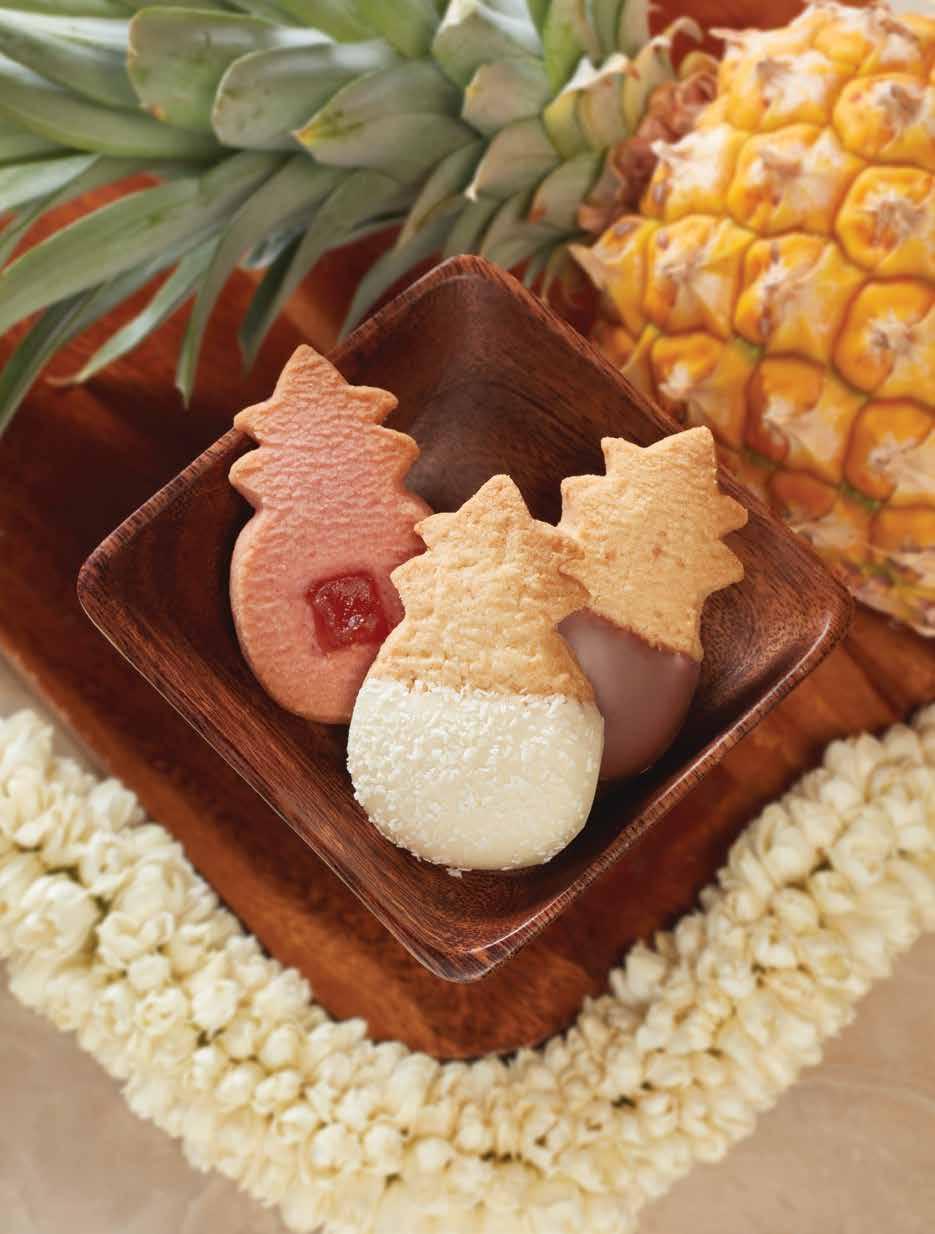


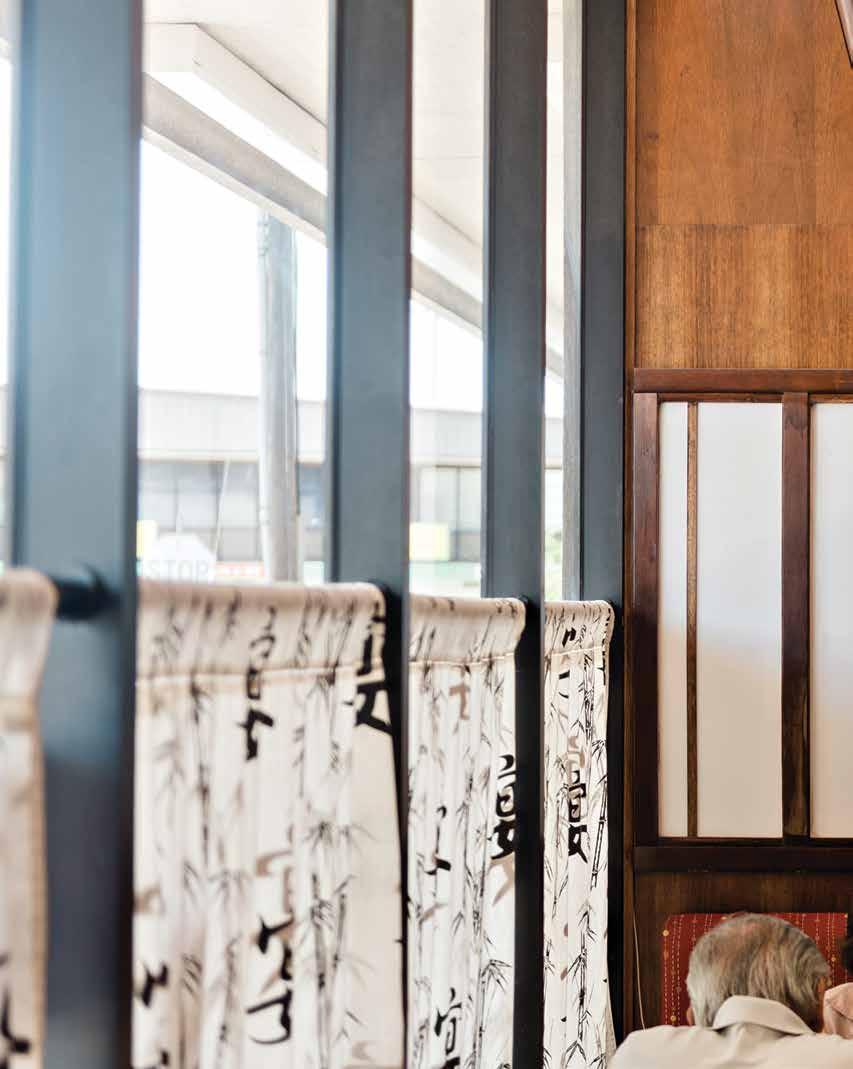

BY
TEXT EUNICA ESCALANTE IMAGES BY JOHN HOOK文=ユーニカ・エスカランテ
写真=ジョン・フック
‘ONO OKINAWA
美味しい沖縄
Explore the eateries that bring delicious Okinawan fare to O‘ahu.
沖縄料理が楽しめるオアフのレストランを探訪


Thick slabs of pork belly marinated in black sugar and soy sauce; delicate cubes of tofu stir-fried into the sharp taste of bitter melon; a broth of fresh mushrooms and thin, tender strips of pork stomach—dishes such as these have been enjoyed in Okinawa for hundreds of years. The fare has bold flavors cultivated from centuries of cross-cultural influence from China and Southeast Asia and has been considered the cause of Okinawans’ longer than average lifespans. Yet it is often overshadowed by more familiar Japanese cuisine.
Though Okinawa has been a part of Japan since 1879, the country’s cuisine is distinct from that of mainland Japan. In fact, it more closely resembles Chinese cooking, a result of the islands’ cultural and political connections to China prior to its Japanese annexation. The result is a menu with a heavy emphasis on pork, considered the essence of Okinawan food. Its geographic location also lends a lush subtropical climate where a range of vegetables thrive.
Okinawans immigrated to Hawai‘i at the turn of the 20th century. While restaurants specializing in Okinawan cuisine are still few and far between, the fare of these O‘ahu eateries will satisfy any visitor craving a taste of Okinawa.
豚バラ肉を黒糖と醤油でとろとろに煮込んだラフテー。苦瓜と豆腐を 炒めたゴーヤチャンプルー。豚モツと椎茸を出汁で煮た中味汁。どれも 伝統的な沖縄の郷土料理だ。長年にわたる中国や東南アジアといった 異文化からの影響によって培われた沖縄料理は、沖縄の人々の長寿の 秘訣とも言われるが、一般的な日本食に比べその知名度は低い。
1879年に日本に併合された沖縄の料理は、豚肉を使ったもの が多いという点で、仏教の教えにより明治時代まで肉食が禁じられて いた本土の日本料理と大きく異なる。併合以前、中国大陸と文化的か つ政治的に結びつきの強かった沖縄の食文化は中国色が濃く、ゆえに 豚肉は沖縄料理には欠かせないものとなっている。地理的にも南にあ り、亜熱帯気候の沖縄では、栄養価の高い野菜が栽培しやすいといっ たこともある。
20世紀初頭には、多くの人々が沖縄からハワイへ移住した。オア フ島の沖縄料理レストランは数少ないものの、異国情緒を味わえる本 格的な沖縄料理に出会えるはずだ。

沖縄料理の多くには様々な方法で調理された豚肉が使 われている。
The simple exterior of Sunrise Restaurant looks unassuming among the glowing neon lights that dot Kapahulu Avenue. Situated around the corner from Hawai‘i icons like Rainbow Drive-In and Leonard’s Bakery, it is easy to miss. But owner and chef Chokatsu Tamayose is not interested in drawing in long lines of hungry tourists. His clientele is smaller, more exclusive.
Stepping inside, I’m struck by how homey the restaurant feels. The atmosphere gives the impression of visiting a relative’s house for dinner. Family pictures and personal memorabilia decorate the walls. Okinawan folk music plays over the speakers. As I pore over the menu, I am engulfed by conversations in Japanese, and I realize that I am the only non-Japanese speaker in the place.
Sunrise was opened in 1999 by Chokatsu and his aunt Kiyo Irei. Today, he runs the restaurant with his wife, Tomoko Tamayose. They serve a pareddown menu of Okinawan dishes similar to those Chokatsu grew up eating. The oxtail soup is lovingly prepared, resulting in tender meat that falls off the bone. Its Okinawan soba, unlike Japanese soba, is made with thick wheat flour noodles that resemble udon and has a light broth garnished simply with green onions and a slice of rafute, or shoyu pork.
Each plate has the option of a side of sushi, which Chokatsu rolls by hand. Thick slabs of the day’s catch line his sushi station, and guests who choose to sit at the bar can watch the chef prepare each piece by hand. Chokatsu makes a limited amount of each dish every day, but there is no need to worry. If one’s first choice runs out, Tomoko has a lineup of other dishes to suggest.
サンライズ・レストラン サンライズ・レストランは、派手なネオン看板を掲げたカパフル通りの 他のレストランに比べると控えめな外観で、レインボー・ドライブインや レナーズベーカリーのようなハワイの人気店のすぐそばにありながら、 見過ごされがちだ。お腹をすかせた観光客が行列を作る店ではなく、少 人数の客にゆっくり食事を楽しんでもらえる居心地の良い店にしたいと いうのが、オーナーシェフのチョカツ・タマヨセさんのモットーだ。 中へ入ると、意外にも家庭的な印象に驚かされる。親戚の家の夕 食に呼ばれたような気分だ。店内には、家族の写真や思い出の品が飾 られ、沖縄の民俗音楽が流れている。メニューを見ていると日本語の会 話が耳に入ってくる。周りを見回すと外国人客は私だけだ。
1999年にチョカツさんと叔母のキヨ・イレイさんがオープンしたサンラ イズ・レストランは現在、チョカツさんと妻のトモコさんが切り盛りして いる。チョカツさんが子供の頃食べて育ったシンプルな沖縄家庭料理 のメニューを提供している。オックステールスープは、肉が骨から落ちる ほど柔らかくなるまで長時間かけて煮込んだ愛情たっぷりの看板メニ ューだ。沖縄そばは、そば粉で作るそばとは違い、きしめんうどんに似 た太い麺で、ラーメンのような色の薄いスープに、ネギとラフテーの薄切 りをトッピングしたシンプルなものだ。
チョカツさんが握る寿司は、どのプレートにも追加して注文でき る。ぶ厚い切り身が並ぶ寿司カウンターで、その日獲れたての魚を慣れ た手つきで捌き、目の前で寿司に握ってくれる。チョカツさんが毎日手 作りする料理は、どれも数が限られているが、希望のメニューが売り切 れたとしても、ともこさんが他のおすすめ料理を作ってくれるので心配 無用だ。
 沖縄料理は、本土の一般的な日本料理とは異なる。
沖縄料理は、本土の一般的な日本料理とは異なる。
izakaya naru
Izakaya Naru is one of those special eateries stumbled upon on while exploring the city, a wellkept secret where a worldly patron brings friends to toast awamori, Okinawa’s version of shochu, and share platters of grilled beef tongue well into the night. It is a place that leaves guests sated and with maybe too much Orion, the unofficial beer of Okinawa, in the belly.
In the past decade, izakayas have popped up across Honolulu. These restaurants gained popularity in Japan as a casual place to grab drinks and chat over tapas-style dishes after work. Part of a restaurant chain with nine locations across Japan, Izakaya Naru has a rustic aesthetic with an all-wood interior, polished wooden tables, and low stools covered in traditional Japanese-print cloth.
When I arrive, the folk music can hardly be heard over the hum of conversation. The place is intimate, holding no more than 30 guests, which means it often requires reservations. But the experience and fare are certainly worth the wait.
I ordered one of its specialties, taco rice, which is another example of foreign influence on Okinawan cuisine. With the establishment of American military bases in Okinawa after World War II came an introduction of Western dishes. Soon, the popular American take on tacos featuring heavily seasoned ground meat was adapted by local chefs. At Izakaya Naru, spiced ground meat, raw egg, and taco fixings of shredded cabbage, onions, tomatoes, and cheese are mixed with rice and served sizzling in a stone bowl. Rounding out my meal is a helping of awamori, a distilled, rice-based liquor. Izakaya Naru’s awamori is made in-house in several flavors and can be ordered in flights, a must for first timers.
居酒屋成ル ワイキキからほど近いエリアにある隠れ家的な居酒屋成ルでは、沖縄 焼酎の泡盛、牛タンの塩焼きなど、沖縄を中心とする美味しい居酒屋 料理と沖縄のオリオンビールを深夜まで味わえる。店内は、友人との 楽しい談話や美味しい酒と肴を楽しむ国際色豊かな客層で賑わって いる。
この10年でホノルルには多くの居酒屋がオープンし、そのうちの 一つである居酒屋成ルは、日本国内に9店舗を展開する居酒屋チェー ンの海外支店だ。木目のインテリアに磨き上げられた木製のテーブル、 和風のカウンター椅子が置かれた店内は素朴な印象で居心地が良い。 店に着くと、BGMの歌謡曲が聞こえないほど賑やかに会話が行 き交っている。こじんまりとした店内には30人も入れば満席なので、予 約をしていなければ待つ覚悟が必要だが、その価値は十分にあろう。 人気メニューのタコライスを注文。タコライスもまた、外国の食文 化の影響を取り入れてきた沖縄料理ならではのメニューのひとつだ。第 二次世界大戦後、米軍基地が建設された沖縄では、西洋料理が食べら れるようになり、アメリカ人の間で人気のあった濃い味のひき肉を使っ たタコスを地元のシェフたちが真似て作るようになった。居酒屋成ルの タコライスは、熱々の石焼鍋に入ったご飯に、スパイスの効いたひき肉、 生卵、細切りキャベツ、玉ねぎ、トマト、チーズといったタコスのトッピン グを混ぜ合わせて食べる。どの料理にも沖縄名物の泡盛が合う。居酒 屋成ルでは、自社製の泡盛も扱っている。初めての人は、何種類かをテ イスティングできるフライトを注文して飲み比べるのもおすすめだ。

a traditional food experience.
地元の沖縄料理店では、伝統的な食文化を体験できる家族向けの料 理を提供している。
utage restaurant and lounge
When I arrive, Utage Restaurant and Lounge is packed, as it often is during the weekday lunch hour. The restaurant is filled with regulars as well as newcomers who, like me, have been ushered in by friends’ recommendations.
Utage is Japanese for “gathering place.” One of the more popular Okinawan restaurants in Honolulu, it has lived up to its namesake. Located in the heart of Kalihi, Utage has served Okinawan fare since it was opened by owner Jocelyn Koshimoto in 2001.
Pork is the preferred protein in Okinawa. “Every meal begins with pork and ends with pork,” an Okinawan proverb states. In Okinawan fashion, visitors to Utage can choose from a variety of porkbased meals. There is the rafute, or shoyu pork, for which the restaurant is best known. The thick cuts of pork belly are slow-cooked in black sugar and soy sauce before being served on a bed of white rice or in a stir-fry. For those wanting lesser known dishes, there is nakami, thin slices of pig stomach cooked simply with onion and sugar, served in stir-fry or a broth of mushrooms with konyaku, a chewy, gelatinous garnish made from konjac potatoes. Of course, no Okinawan menu would be complete without the signature pig’s feet dish. At Utage, a generous portion of pig’s feet is served in a soup of daikon (winter radish), konbu (kelp), and mustard cabbage.
宴レストラン&ラウンジ
店に着くと、店内はすでに満席。平日のランチ時間帯は決まってこう だという。この店は、常連客や私のように友人に勧められて初めて 来店する多くの客で常に賑わっている。
2001年にオーナーのジョセリン・コシモトさんがカリヒの中 心部にオープンした宴レストラン&ラウンジは、「宴=集う場所」と いう名前がぴったりのホノルルで最も人気のある沖縄レストランの 一つだ。
「豚に始まり、豚に終わる」と言われるほど、豚肉が食生活の 中心にある沖縄。宴でも多くの豚を使ったメニューを味わえる。豚ば ら肉の厚切りを黒糖と醤油でゆっくり煮込んだ看板メニューのラフ テーは、白米にのせたり炒め物に混ぜていただく。玉ねぎと砂糖で シンプルな味に煮込んだ豚モツ薄切りは、炒め料理にしたり、こんに ゃくや椎茸とその戻し汁で煮たスープに入れて食べる。そして沖縄 料理を語る上で欠かせないのが豚足だ。宴では、大根と昆布とから し菜にたっぷりの豚足が入ったスープを味わえる。



IMAGES FROM HAWAI ‘ I STATE
ARCHIVES & KEALAKAI
CENTER FOR PACIFIC STRINGS
文=クリスティン・ヒット
写真=ハワイ州立公文書館、 ケアラカイ・センター・フォー・ パシフィック・ストリングス
A MUSICAL PIONEER CULTURE
音楽のパイオニア
During a pivotal moment in the history of the Hawaiian Kingdom, conductor Mekia Kealakai forever preserved and changed Hawaiian and American music as we know them.
ハワイ王国が迎えた激動の時代、ハワイとアメリカの音楽を永遠に変えた指揮者、メキア・ケアラカイ
A gifted musician at the turn of the 19th century, Mekia Kealakai (1867–1944), below, was at the forefront of Hawaiian music.
19世紀を代表する奇才音
楽家のメキア・ケアラカイ (1867–1944)(右)は、ハワ イアンミュージックの最前線 にいた。


The music by the great bands and musicians of Hawai‘i didn’t stop as their kingdom was overthrown. Performing in exhibitions in the United States and beyond in the late 19th and early 20th centuries, Hawaiian musicians looked for support for the monarchy while spreading their unique style of string band music to millions of people.
“When most people talk about the origin of traditional American music, they talk about the 1920s, but these guys were crisscrossing the continental United States in the 1870s and 1880s nonstop,” says Kilin Reece, luthier and owner of KR Strings in Kailua. Reece, who also founded the nonprofit Kealakai Center for Pacific Strings, has been researching the impacts of these musicians since 2014.
ハワイの音楽は、偉大なるバンドやミュージシャンたちの努力によっ て、ハワイ王国転覆後も廃れることはなかった。19世紀後半から20世 紀初頭にかけて、米国内外の博覧会で演奏活動を行っていたハワイア ンのミュージシャンたちは、ハワイ独自の弦楽合奏団の音楽を世界中 に広め、ハワイの君主制への支持を求めた。
「アメリカの伝統音楽の起源といえば、ほとんどの人が1920年 代を思い浮かべるけど、音楽家たちは1870年代から1880年代にか けて、すでにアメリカ大陸を自由に往来していたんだ」と語るのは、カイ ルアにあるKRストリングスのオーナーで弦楽器職人のキリン・リース さん。彼は、これらのミュージシャンが与えた影響について研究する非 営利団体「ケアラカイ・センター・フォー・パシフィック・ストリングス」 を2014年に設立した。
Halekulani

String band music emphasizes guitar accompanied by ‘ukulele, mandolin, banjo, violin, and sometimes flute. This ensemble style, which was spread around the world by Hawaiian musicians, influenced country, bluegrass, Western swing, and jazz music, which everybody thinks of as American, Reece says, but his research shows have deep roots in the Kingdom of Hawai‘i.
One person at the forefront of this movement was Mekia Kealakai. A gifted musician who studied under Royal Hawaiian Band conductor Henry Berger at a reform school in Honolulu, Kealakai learned guitar, trombone, piano, and flute. After graduating at age 15, Kealakai was recruited into the Royal Hawaiian Band, where he played until the overthrow in 1893. Kealakai quit to show support for the monarchy and became part of the Hawaiian National Band, made up largely of Native Hawaiian former Royal Hawaiian Band members, which went on tour of the continental U.S.. Kealakai later joined other bands and toured the United States and Europe for more than 20 years. He met his wife, hula dancer Mele Nawa‘aheihei, at the 1901 World’s Fair in New York, and they performed together in London, Paris, and Cannes.
During Kealakai’s travels, he composed songs inspired by his homeland such as “Wai‘alae,” “Kawaihau Waltz,” “E Pele E,” and “Kō Leo.” Perhaps his most famous composition, though, is “Lei ‘Awapuhi,” inspired by passing fields of daisies he saw from a train. The song continues to be recorded by Hawaiian artists.
ギターを中心とする弦楽合奏団の音楽は、ウクレレやマンドリ ン、バンジョー、バイオリン、そして時にフルートを伴う。ハワイアンのミ ュージシャンたちによって世界中に広められたこのアンサンブル形式 は、カントリー、ブルーグラス、ウエスタンスウィングに影響を与え、リー スさんの研究によると、誰もがアメリカ音楽と考えるジャズも深く掘り 下げれば、そのルーツはハワイ王国にあるという。
その第一線で活躍したのが、メキア・ケアラカイさんだ。貧しい 家庭に育ち、ホノルルの教護院で巡り合ったロイヤルハワイアンバンド の指揮者、ヘンリー・バーガー氏のもと、ギターやトロンボーン、ピアノ、 フルートを学んで才能を開花させ、ハワイを代表する偉大なミュージ シャンとなった人物である。ケアラカイさんは15歳で卒業後、ハワイ王 朝専属のロイヤルハワイアンバンドに入団し、1893年まで演奏を続け た。君主制への忠誠を誓った彼は、ハワイ王国転覆後にバンドを去る と、主にネイティブハワイアンの元ロイヤルハワイアンバンドメンバーで 構成されたハワイアンナショナルバンドに加わり、米国大陸をツアー。 その後も他のバンドとともに、20年以上にわたってアメリカやヨーロッ パをツアーで巡った。1901年には、ニューヨーク世界万博で、妻でフ ラダンサーのメレ・ナヴァアヘイヘイさんと出会う。二人はロンドン、パ リ、そしてカンヌでも共演した。 ケアラカイさんはツアー中、故郷に想いを馳せた名曲の「ワイア ラエ」、「カヴァイハウ・ワルツ」、「エ・ペレ・エ」、「コー・レオ」などを作曲 している。彼の作曲の代表作でもある「レイ・アワプヒ」は、電車から見 えるヒナギク畑の景色を歌ったもので、この名曲は今でもハワイアンア ーティストたちの間で歌われ続けている。

An unidentified hula dancer with a 6-string acoustic guitar, a favored implement that would circle the globe with Hawaiian hula troupes in the later decades of the 19th century.
6本の弦のアコースティックギターと写っているあるフ ラダンサー。19世紀後半、ハワイのフラグループに好 んで使用されたギターは、ダンサーたちと共に世界中 を旅した。
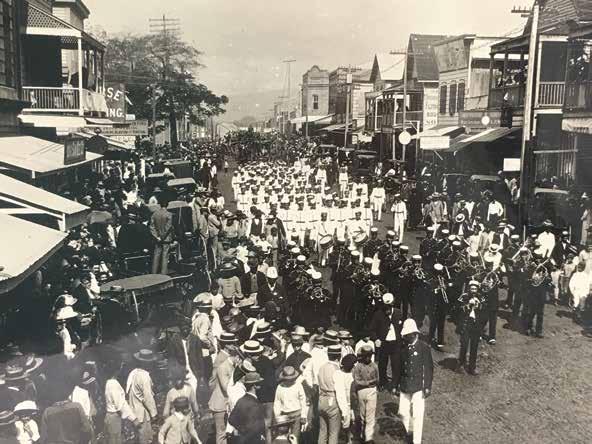
Kalākaua Coronation Celebration parade and Royal Hawaiian Band, followed by Keoneula Boys Industrial School, February 12th, 1883. Kealakai is seen playing trombone.
カラカウア・コーポレーション・セレブレーション・パレードとロイヤル ハワイアンバンド。それに続くケオネウラ・ボーイズ・インダストリアル・ スクール。1883年2月12日。この時、ケアラカイさんはトロンボーン を演奏していた。

The Honolulu Students, circa 1907. String band music emphasizes guitar accompanied by ‘ukulele, cello, guitars, and sometimes the flute. Lui Keouli Thompson, the uncle of Duke Kahanamoku, led the band with his violin and baritone vocals.
ザ・ホノルル・スチューデン ツ。1907年頃。ギターを中心と する弦楽合奏団の音楽は、ウク レレやマンドリン、バンジョー、 バイオリン、そして時にフルート を伴った。デューク・カハナモク の叔父で、バイオリン奏者とバリ トーンのヴォーカルを担当した ルイ・ケオウリ・トンプソンが率 いたバンド。

In 1915, Kealakai collaborated with Martin Guitar Company while in New York to produce the ancestor of the famous dreadnought guitar, giving it a larger body for louder sound and a raised bridge for slide playing. Kealakai was also lifelong friends with Joseph Kekuku, the inventor of the steel guitar. The dreadnought would go on to be played by Johnny Cash, Paul McCartney, Hank Williams, and Elvis Presley.
“As I started to really get into Mekia’s story, it became clear to me that he and his generation had really done something incredible and had never received credit for it,” Reece says. “I feel like the more important conversation to have now is how did this cultural concept of sound and music and dance in Hawaiian communities, going back thousands of years, how did that vision of sound and song shape and influence the way people were playing instruments and playing music and ultimately the very design of those instruments?” Reece says.
1915年、ケアラカイさんはニューヨークに滞在中、マーティン・ ギター・カンパニーと共同で、大きな音の出る大きめのボディと高いブ リッジでスライド演奏を可能にする、のちに “ドレッドノートギター” と して知られるギターの原型を開発した。ケアラカイさんは、スチールギ ターの発案者であるジョセフ・ケクク氏とも生涯の友であった。ドレッ ドノートギターはその後、ジョニー・キャッシュやポール・マッカートニ ー、ハンク・ウィリアムズ、エルヴィス・プレスリーなどに使用されるよう になった。
リースさんは、「メキアの生涯について掘り下げるうちに、彼をは じめとする当時のアーティストたちが、想像を超える偉業を成し遂げて いたにもかかわらず、その事実がほとんど知られていないことに気づい たんだ」と話す。「何千年も昔からハワイアンの社会にあった音や音楽 や踊りの文化的な概念や歌のビジョンが、現在われわれの知る音楽を どのように形成し、楽器の演奏法やデザインそのものにどんな影響を 及ぼしたかについて掘り下げる必要があるんだ」。
Halekulani



 TEXT BY LINDSEY KESEL
IMAGES BY JOHN HOOK
TEXT BY LINDSEY KESEL
IMAGES BY JOHN HOOK

















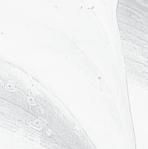
































































































 Dress, Here.; from Here. Sunglasses, Chloé; from Saks Fifth Avenue
Tiffany HardWear double link pendant in 18k gold; from Tiffany & Co.
Dress, Here.; from Here. Sunglasses, Chloé; from Saks Fifth Avenue
Tiffany HardWear double link pendant in 18k gold; from Tiffany & Co.
 Tiffany HardWear ball pendant in 18k white gold with diamonds, Tiffany HardWear ball ring in 18k white gold with diamond; both from Tiffany & Co.
Tiffany HardWear ball pendant in 18k white gold with diamonds, Tiffany HardWear ball ring in 18k white gold with diamond; both from Tiffany & Co.


 Dress, Carolina K; from Saks Fifth Avenue Hat, Communitie; from Here.
Dress, Carolina K; from Saks Fifth Avenue Hat, Communitie; from Here.
 Bag, Staud; from Saks Fifth Avenue
Tiffany T two ring in 18k white gold with pavé; from Tiffany & Co.
Bag, Staud; from Saks Fifth Avenue
Tiffany T two ring in 18k white gold with pavé; from Tiffany & Co.
 Jumpsuit, Pleats Please Issey Miyake; from Saks Fifth Avenue
Tiffany HardWear link bracelet in 18k gold, Tiffany HardWear link pendant in 18k gold; both from
Tiffany & Co.
Jumpsuit, Pleats Please Issey Miyake; from Saks Fifth Avenue
Tiffany HardWear link bracelet in 18k gold, Tiffany HardWear link pendant in 18k gold; both from
Tiffany & Co.












 TEXT BY ROBERT BECKER
IMAGES BY
CHRIS ROHRER
TEXT BY ROBERT BECKER
IMAGES BY
CHRIS ROHRER



































































